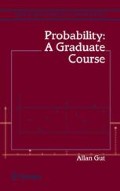Abstract
The law of large numbers states that the arithmetic mean of independent, identically distributed random variables converges to the expected value. One interpretation of the central limit theorem is as a (distributional) rate result. Technically, let X, X1, X2, . . . be independent, identically distributed random variables with mean μ. The weak and strong laws of large numbers state that \(\frac{1} {n}\sum\nolimits_{k = 1}^n {X_k \to \mu } \) in probability and almost surely, respectively, as n→∞. A distributional rate result deals with the question of how one should properly “blow up” the difference \( \frac{1} {n}\sum\nolimits_{k = 1}^n {X_k - \mu } \) in order for the limit to have a non-trivial limit as n tends to infinity. The corresponding theorem was first stated by Laplace. The first general version with a rigorous proof is due to Lyapounov [178, 179].
Access this chapter
Tax calculation will be finalised at checkout
Purchases are for personal use only
Preview
Unable to display preview. Download preview PDF.
Rights and permissions
Copyright information
© 2005 Springer Science+Business Media, Inc.
About this chapter
Cite this chapter
(2005). The Central Limit Theorem. In: Probability: A Graduate Course. Springer Texts in Statistics. Springer, New York, NY. https://doi.org/10.1007/0-387-27332-8_7
Download citation
DOI: https://doi.org/10.1007/0-387-27332-8_7
Publisher Name: Springer, New York, NY
Print ISBN: 978-0-387-22833-4
Online ISBN: 978-0-387-27332-7
eBook Packages: Mathematics and StatisticsMathematics and Statistics (R0)

